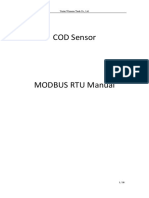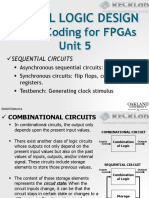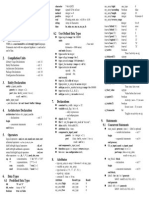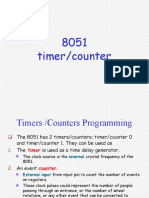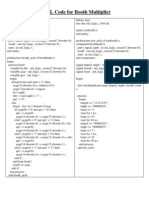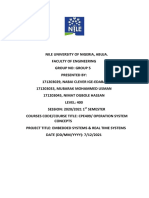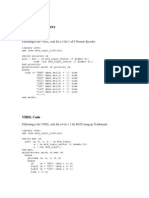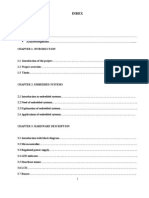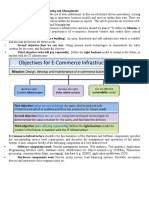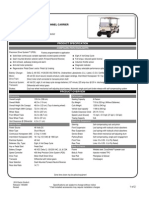Figure 11-1 Serial Data Transmission
U RxD COMPUTER A R TxD T M O D E M telephone line M O D E M RxD U A COMPUTER TxD R T
Figure 11-2 Standard Serial Data Format
8 data bits D 0 Start Bit 1 0 1 0 1 0 1 0 1
7-bit ASCII code LSB first
Parity bit Stop bit (even)
�Figure 11-3 UART Block Diagram
Data Bus 8
RDR RxD RSR Receiver Control SCSR
TD RD RE RF OE FE
SCCR
TIE RIE 3
Ld
SEL SEL SEL 2 1 0
TDR 1 TSR Transmitter Control Transmitter 1 TxD
BAUD Rate BClkx8 Generator BClk
Receiver
�Figure 11-4 SM Chart for UART Transmitter
IDLE 1 0 load TSR set TDRE SYNCH 0 1
clear TSR(0)
TDRE
BCLK
start bit
TDATA 0 1 shift TSR inc Bct 0
BCLK
clear Bct
Bct=9
�Figure 11-5(a) VHDL Code for UART Transmitter
library ieee; use ieee.std_logic_1164.all; entity UART_Transmitter is port(Bclk, sysclk, rst_b, TDRE, loadTDR: in std_logic; DBUS:in std_logic_vector(7 downto 0); setTDRE, TxD: out std_logic); end UART_Transmitter; architecture xmit of UART_Transmitter is type stateType is (IDLE, SYNCH, TDATA); signal state, nextstate : stateType; signal TSR : std_logic_vector (8 downto 0); -- Transmit Shift Register signal TDR : std_logic_vector(7 downto 0); -- Transmit Data Register signal Bct: integer range 0 to 9; -- counts number of bits sent signal inc, clr, loadTSR, shftTSR, start: std_logic; signal Bclk_rising, Bclk_dlayed: std_logic; begin TxD <= TSR(0); setTDRE <= loadTSR; Bclk_rising <= Bclk and (not Bclk_dlayed); -- indicates the rising edge of bit clock Xmit_Control: process(state, TDRE, Bct, Bclk_rising) begin inc <= '0'; clr <= '0'; loadTSR <= '0'; shftTSR <= '0'; start <= '0'; -- reset control signals case state is when IDLE => if (TDRE = '0' ) then loadTSR <= '1'; nextstate <= SYNCH; else nextstate <= IDLE; end if;
�Figure 11-5(b) VHDL Code for UART Transmitter
when SYNCH => -- synchronize with the bit clock if (Bclk_rising = '1') then start <= '1'; nextstate <= TDATA; else nextstate <= SYNCH; end if; when TDATA => if (Bclk_rising = '0') then nextstate <= TDATA; elsif (Bct /= 9) then shftTSR <= '1'; inc <= '1'; nextstate <= TDATA; else clr <= '1'; nextstate <= IDLE; end if; end case; end process; Xmit_update: process (sysclk, rst_b) begin if (rst_b = '0') then TSR <= "111111111"; state <= IDLE; Bct <= 0; Bclk_dlayed <= '0'; elsif (sysclk'event and sysclk = '1') then state <= nextstate; if (clr = '1') then Bct <= 0; elsif (inc = '1') then Bct <= Bct + 1; end if; if (loadTDR = '1') then TDR <= DBUS; end if; if (loadTSR = '1') then TSR <= TDR & '1'; end if; if (start = '1') then TSR(0) <= '0'; end if; if (shftTSR = '1') then TSR <= '1' & TSR(8 downto 1); end if; -- shift out one bit Bclk_dlayed <= Bclk; -- Bclk delayed by 1 sysclk end if; end process; end xmit;
�From Page 378 Operation of UART Receiver 1. When the UART detects a start bit, it reads in the remaining bits serially and shifts them into the RSR. 2. When all of the data bits and the stop bit have been received, the RSR is loaded into the RDR, and the Receive Data Register Full flag (RDRF) in the SCSR is set. 3. The microcontroller checks the RDRF flag, and if it is set, the RDR is read and the flag is cleared.
Figure 11-6 Sampling RxD with BclkX8 start bit RxD * BclkX8 4 clocks * Read data at these points 8 clocks 8 clocks * * 1st data bit 2nd data bit
�Figure 11-7 SM Chart for UART Receiver
IDLE 1 0 Start Detected 0
Receive Data 0
RxD
Bclkx8
set RDRF clr1 clr2
1 inc1 0 1
Bclkx8
1 clr1 1 RxD clr1 1 0 0
Ct1=7
shift RSR inc2 clr1 inc1
Ct2=8
Ct1=3
1
RDRF
OE
0
RxD
FE
stop bit
1 load RDR
�Figure 11-8(a) VHDL Code for UART Receiver
library ieee; use ieee.std_logic_1164.all; entity UART_Receiver is port(RxD, BclkX8, sysclk, rst_b, RDRF: in std_logic; RDR: out std_logic_vector(7 downto 0); setRDRF, setOE, setFE: out std_logic); end UART_Receiver; architecture rcvr of UART_Receiver is type stateType is (IDLE, START_DETECTED, RECV_DATA); signal state, nextstate: stateType; signal RSR: std_logic_vector (7 downto 0); -- receive shift register signal ct1 : integer range 0 to 7; -- indicates when to read the RxD input signal ct2 : integer range 0 to 8; -- counts number of bits read signal inc1, inc2, clr1, clr2, shftRSR, loadRDR : std_logic; signal BclkX8_Dlayed, BclkX8_rising : std_logic; begin BclkX8_rising <= BclkX8 and (not BclkX8_Dlayed); -- indicates the rising edge of bitX8 clock Rcvr_Control: process(state, RxD, RDRF, ct1, ct2, BclkX8_rising) begin -- reset control signals inc1 <= '0'; inc2 <= '0'; clr1 <= '0'; clr2 <= '0'; shftRSR <= '0'; loadRDR <= '0'; setRDRF <= '0'; setOE <= '0'; setFE <= '0';
�Figure 11-8(b) VHDL Code for UART Receiver
case state is when IDLE => if (RxD = '0' ) then nextstate <= START_DETECTED; else nextstate <= IDLE; end if; when START_DETECTED => if (BclkX8_rising = '0') then nextstate <= START_DETECTED; elsif (RxD = '1') then clr1 <= '1'; nextstate <= IDLE; elsif (ct1 = 3) then clr1 <= '1'; nextstate <= RECV_DATA; else inc1 <= '1'; nextstate <= START_DETECTED; end if; when RECV_DATA => if (BclkX8_rising = '0') then nextstate <= RECV_DATA; else inc1 <= '1'; if (ct1 /= 7) then nextstate <= RECV_DATA; -- wait for 8 clock cycles elsif (ct2 /= 8) then shftRSR <= '1'; inc2 <= '1'; clr1 <= '1'; -- read next data bit nextstate <= RECV_DATA; else nextstate <= IDLE; setRDRF <= '1'; clr1 <= '1'; clr2 <= '1'; if (RDRF = '1') then setOE <= '1'; -- overrun error elsif (RxD = '0') then setFE <= '1'; -- framing error else loadRDR <= '1'; end if; -- load recv data register end if; end if; end case; end process;
�Figure 11-8(c) VHDL Code for UART Receiver
Rcvr_update: process (sysclk, rst_b) begin if (rst_b = '0') then state <= IDLE; BclkX8_Dlayed <= '0'; ct1 <= 0; ct2 <= 0; elsif (sysclk'event and sysclk = '1') then state <= nextstate; if (clr1 = '1') then ct1 <= 0; elsif (inc1 = '1') then ct1 <= ct1 + 1; end if; if (clr2 = '1') then ct2 <= 0; elsif (inc2 = '1') then ct2 <= ct2 + 1; end if; if (shftRSR = '1') then RSR <= RxD & RSR(7 downto 1); end if; -- update shift reg. if (loadRDR = '1') then RDR <= RSR; end if; BclkX8_Dlayed <= BclkX8; -- BclkX8 delayed by 1 sysclk end if; end process; end rcvr;
�Figure 11-9 Synthesized UART receiver
CT2
FDCE
RSR
FDCE
D C CLR Q
incrementer
CT1
FDCE
D C CLR Q
D C CLR
RDR
FDCE
D C CLR Q RDR[7,0] Q PWR VDD
FDCE
FDCE
D C CLR
incrementer
Q
D C CLR
FDCE
D C CLR
FDCE
D C CLR Q
FDCE
D C CLR Q
FDCE
D C CLR Q
FDCE FDCE
D C CLR Q C CLR
FDCE
D C CLR Q
FDCE
D Q
D C CLR
FDCE
D C CLR Q
FDCE
D C CLR Q
FDCE
D C CLR Q
FDCE
D C CLR Q
GND
FDCE
D C CLR Q
GND
FDCE
D C CLR SETRDRF Q
state(0)
RXD
FDCE
D Q CLR
FDCE
D Q CLR C
FDCE
D C CLR Q
FDCE
D C CLR Q
state(1)
FDCE
D Q CLR C
BCLKXB VDD SYSCLK RESET
FDCE
D C CLR Q
SETFE
RDRFIN
SETDE
Bclkx8-Dlyed
�Figure 11-10 Baud Rate Generator
BclkX8
Bclk divide by 8 BclkX8 MUX select
8 MHz clk
divide by 13
Clkdiv13
divide by 256
BAUD Rate (Bclk) 38462 19231 9615 4808 2404 1202 601 300.5
Select Bits 000 001 010 011 100 101 110 111
�Figure 11-11(a) VHDL Code for BAUD Rate Generator
library ieee; use ieee.std_logic_1164.all; use ieee.std_logic_unsigned.all; entity clk_divider is port(Sysclk, rst_b: in std_logic; Sel: in std_logic_vector(2 downto 0); BclkX8: buffer std_logic; Bclk: out std_logic); end clk_divider; architecture baudgen of clk_divider is signal ctr1: std_logic_vector (3 downto 0):= "0000"; -- divide by 13 counter signal ctr2: std_logic_vector (7 downto 0):= "00000000"; -- div by 256 ctr signal ctr3: std_logic_vector (2 downto 0):= "000"; -- divide by 8 counter signal Clkdiv13: std_logic; begin process (Sysclk) begin if (Sysclk'event and Sysclk = '1') then if (ctr1 = "1100") then ctr1 <= "0000"; else ctr1 <= ctr1 + 1; end if; end if; end process; -- first divide system clock by 13
-- use '+' operator, CONV_INTEGER func.
�Figure 11-11(b) VHDL Code for BAUD Rate Generator
Clkdiv13 <= ctr1(3); process (Clkdiv13) begin if (rising_edge(Clkdiv13)) then ctr2 <= ctr2 + 1; end if; end process; BclkX8 <= ctr2(CONV_INTEGER(sel)); process (BclkX8) begin if (rising_edge(BclkX8)) then ctr3 <= ctr3 + 1; end if; end process; Bclk <= ctr3(2); end baudgen; -- divide Sysclk by 13 -- clk_divdr is an 8-bit counter
-- select baud rate
-- Bclk is BclkX8 divided by 8
�Figure 11-12(a) VHDL Code for Complete UART
library ieee; use ieee.std_logic_1164.all; entity UART is port (SCI_sel, R_W, clk, rst_b, RxD : in std_logic; ADDR2: in std_logic_vector(1 downto 0); DBUS : inout std_logic_vector(7 downto 0); SCI_IRQ, TxD : out std_logic); end UART; architecture uart1 of UART is component UART_Receiver port (RxD, BclkX8, sysclk, rst_b, RDRF: in std_logic; RDR: out std_logic_vector(7 downto 0); setRDRF, setOE, setFE: out std_logic); end component; component UART_Transmitter port (Bclk, sysclk, rst_b, TDRE, loadTDR: in std_logic; DBUS: in std_logic_vector(7 downto 0); setTDRE, TxD: out std_logic); end component; component clk_divider port (Sysclk, rst_b: in std_logic; Sel: in std_logic_vector(2 downto 0); BclkX8: buffer std_logic; Bclk: out std_logic); end component;
�Figure 11-12(b) VHDL Code for Complete UART
signal signal signal signal signal signal signal begin RCVR: UART_Receiver port map(RxD, BclkX8, clk, rst_b, RDRF, RDR, setRDRF, setOE, setFE); XMIT: UART_Transmitter port map(Bclk, clk, rst_b, TDRE, loadTDR, DBUS, setTDRE, TxD); CLKDIV: clk_divider port map(clk, rst_b, BaudSel, BclkX8, Bclk); -- This process updates the control and status registers process (clk, rst_b) begin if (rst_b = '0') then TDRE <= '1'; RDRF <= '0'; OE<= '0'; FE <= '0'; TIE <= '0'; RIE <= '0'; elsif (rising_edge(clk)) then TDRE <= (setTDRE and not TDRE) or (not loadTDR and TDRE); RDRF <= (setRDRF and not RDRF) or (not clrRDRF and RDRF); OE <= (setOE and not OE) or (not clrRDRF and OE); FE <= (setFE and not FE) or (not clrRDRF and FE); RDR : std_logic_vector(7 downto 0); -- Receive Data Register SCSR : std_logic_vector(7 downto 0); -- Status Register SCCR : std_logic_vector(7 downto 0); -- Control Register TDRE, RDRF, OE, FE, TIE, RIE : std_logic; BaudSel : std_logic_vector(2 downto 0); setTDRE, setRDRF, setOE, setFE, loadTDR, loadSCCR : std_logic; clrRDRF, Bclk, BclkX8, SCI_Read, SCI_Write : std_logic;
�Figure 11-12(c) VHDL Code for Complete UART
if (loadSCCR = '1') then TIE <= DBUS(7); RIE <= DBUS(6); BaudSel <= DBUS(2 downto 0); end if; end if; end process; -- IRQ generation logic SCI_IRQ <= '1' when ((RIE = '1' and (RDRF = '1' or OE = '1')) or (TIE = '1' and TDRE = '1')) else '0'; -- Bus Interface SCSR <= TDRE & RDRF & "0000" & OE & FE; SCCR <= TIE & RIE & "000" & BaudSel; SCI_Read <= '1' when (SCI_sel = '1' and R_W = '0') else '0'; SCI_Write <= '1' when (SCI_sel = '1' and R_W = '1') else '0'; clrRDRF <= '1' when (SCI_Read = '1' and ADDR2 = "00") else '0'; loadTDR <= '1' when (SCI_Write = '1' and ADDR2 = "00") else '0'; loadSCCR <= '1' when (SCI_Write = '1' and ADDR2 = "10") else '0'; DBUS <= "ZZZZZZZZ" when (SCI_Read = '0') -- tristate bus when not reading else RDR when (ADDR2 = "00") -- write appropriate register to the bus else SCSR when (ADDR2 = "01") else SCCR; -- dbus = sccr, if ADDR2 is "10" or "11" end uart1;
�Figure 11-13 Simplified Block Diagram for M68HC05 Microcontroller
Data direction A RAM ROM PA0 PA1 PA2 PA3 PA4 PA5 PA6 PA7 PB0 PB1 PB2 PB3 PB4 PB5 PB6 PB7
CPU Control M68HC05 CPU
ALU
Data direction B
CPU Registers
Accumulator Index register
0 0 0 0 0 1 1
Stack pointer
Condition register 1 1 1 H I N Z C code
UART
Program counter
Port B
Port A
Rxd Txd
�Figure 11-14 MC68HC05C4 Programming Model
7 6 5 4 3 2 1 0 Accumulator (A) 7 6 5 4 3 2 1 0 Index register (X) 12 11 10 9 0 0 0 0 12 11 10 9 8 0 8 7 1 7 6 1 6 5 4 3 2 1 0 Stack pointer (SP) 5 4 3 2 1 0 Program counter (PC) 7 1 6 1 5 1 4 3 H I 2 1 0 N Z C
Condition code register (CCR)
Half-carry flag Interrupt mask Negative flag Zero flag Carry/borrow flag
�Table 11-1 Opcodes for MC6805
Bit Manipulation Branch
BTB Lo Hi 0 BSC 1 REL 2 BRA BRN BHI BLS BCC BCS BNE BEQ ROR ASR LSL ROL DEC ROR ASR LSL ROL DEC ROR ASR LSL ROL DEC ROR ASR LSL ROL DEC ROR ASR LSL ROL DEC TAX CLC SEC CLI SEI INC TST INC TST INC TST INC TST INC TST STOP* CLR CLR CLR CLR CLR WAIT* TXA RSP NOP BSR* LDX EOR ADC ORA ADD COM LSR MUL* COM LSR COM LSR COM LSR COM LSR SWI DIRM 3 NEG
Read/Modify/Write
INHA 4 NEG INHX 5 NEG IX1M 6 NEG IXM 7 NEG
Control
INH1 8 RTI RTS INH2 9 IMM A SUB CMP SBC CPX AND BIT LDA DIR B SUB CMP SBC CPX AND BIT LDA STA EOR ADC ORA ADD JMP JSR LDX STX
Register/Memory
EXT C SUB CMP SBC CPX AND BIT LDA STA EOR ADC ORA ADD JMP JSR LDX STX IX2 D SUB CMP SBC CPX AND BIT LDA STA EOR ADC ORA ADD JMP JSR LDX STX IX1 E SUB CMP SBC CPX AND BIT LDA STA EOR ADC ORA ADD JMP JSR LDX STX IX F SUB CMP SBC CPX AND BIT LDA STA EOR ADC ORA ADD JMP JSR LDX STX
0 1 2 3 4 5 6 7 8 9 A B C D E F
BRSET0* BSET0* BRCLR0* BCLR0* BRSETI* BSETI* BRCLR1* BCLR1* BRSET2* BSET2* BRCLR2* BCLR2* BRSET3* BSET3* BRCLR3* BCLR3*
BRSET4* BSET4* BHCC* BRCLR4* BCLR4* BHCS* BRSET5* BSET5* BRCLR5* BCLR5* BRSET6* BSET6* BRCLR6* BCLR6* BRSET7* BSET7* BRCLR7* BCLR7* BPL BMI BMC BMS BIL* BIH*
*not implemented in this text
�Table 11-2(a) 6805 Instructions: Registermemory Instructions
Symbol ADD ADC SUB SBC CMP CPX AND BIT ORA EOR LDA LDX STA STX JMP JSR Instruction add add with carry subtract compare A compare X and bit test or exclusive-or load A load X store A store X jump jump to subroutine Operation A A+M A A+M+C A A M A M X M A A and M A and M A A or M A A xor M A M X M M A M X jump to EA push PC on stack, jump to EA Flags NZ, C carry NZ, C carry NZ, C borrow NZ, C borrow NZ, C borrow NZ, C borrow NZ NZ NZ NZ NZ NZ NZ NZ
subtract with borrow A A M C
�Table 11-2(b) 6805 Instructions: Readmodifywrite Instructions
Symbol NEG COM TST CLR INC DEC LSL ROL ASR LSR ROR Instruction negate complement test clear increment decrement logical shift left rotate left arithmetic shift right logical shift right rotate right Operation R 0 R R not R 0 R R 0 R R+1 R R 1 R R(6 downto 0) & '0' R R(6 downto 0) & C R '0' & R(7 downto 1) R C & R(7 downto 1) Flags NZ, C borrow NZ, C 1 NZ NZ NZ NZ NZ, C R(7) NZ, C R(7) NZ, C R(0) NZ, C R(0)
R R(7) & R(7 downto 1) NZ, C R(0)
�Table 11-2(c) 6805 Instructions: Control Instructions
Symbol TAX TXA CLC SEC CLI SEI RSP NOP RTI RTS SWI Instruction transfer A to X transfer X to A clear carry set carry clear I set I reset SP no operation return from interrupt return from subroutine software interrupt pop CCR, A, X, PCH, PCL; return to address in PC pop PCH, PCL; return to address in PC push PCL, PCH, X, A, CCR jump to address from interrupt vector table Operation X A A X C '0' C '1' I '0' I '1' SP "111111"
�Table 11-2(d) 6805 Instructions: Branch Instructions
Symbol BRA BRN BHI BLS BCC BCS BNE BEQ BPL BMI BMC BMS Instruction branch always branch never branch if higher branch of lower or same branch if carry clear branch if carry set` branch if not equal branch if equal branch if plus branch if minus branch if int. mask clear branch if int. mask set Branch if always never (C or Z) = '0' (C or Z) = '1' C = '0' C = '1' Z = '0' Z = '1' N = '0' N = '1' I = '0' I = '1'
�Table 11-3 6805 Addressing Modes
Mode Name imm dir, dirm ext ix ixm ix1, ix1m ix2 rel immediate direct extended indexed, no offset indexed, 1-byte offset indexed, 2-byte offset relative Bytes Examples 2 2 3 1 2 3 2 ADD ii ADD dd INC dd ADD hh ll ADD ,X INC ,X ADD ff,X INC ff,X ADD ee ff, X BRA rr Effective Address data = byte 2 of inst. EA = dd EA = hh ll EA = X EA = ff + X EA = (ee ff) + X EA = PC+2+rr* data is in A data is in X opcode implies location of operands
inha, inherent 1 INCA inhx INCX inh1, inherent 1 RTI inh2 TAX *rr is sign-extended before addition
�Table 11-4(a) Cycle-by-Cycle Operations for 6805 Instructions
1st cycle is {fetch} for all instructions
ADD imm 2nd cycle {addr1} Md mem(PC) PC PC + 1 {addr1} MARL mem(PC) PC PC + 1 {addr1} MARL X {addr1} MARL mem(PC) PC PC + 1 {addr1} MARH mem(PC) PC PC + 1 {addr1} MARH mem(PC) PC PC + 1 {addr1} MARH mem(PC) PC PC + 1 {addr1} A A + 1 {addr1} MARL mem(PC) PC PC + 1 {addr1} MARL X {addr1} MARL mem(PC) PC PC + 1 3rd cycle (A A + Md)* {data} Md mem(MAR) {data} Md mem(MAR) {addx} MAR MAR+ X {addr2} MARL mem(PC) PC PC + 1 {addr2} MARL mem(PC) PC PC + 1 {addr2} MARL mem(PC) PC PC + 1 {data} Md mem(MAR) {data} Md mem(MAR) {addx} MAR MAR+ X (A A + Md)* (A A + Md)* {data} Md mem(MAR) {data} Md mem(MAR) {addx} MAR MAR + X {data} mem(MAR) A 4th cycle 5th cycle 6th cycle
ADD dir
ADD ix ADD ix1
(A A + Md)* (A A + Md)* {data} Md mem(MAR) (A A+Md)*
ADD ext
ADD ix2
STA ext
INC A INC dirm
{rd_mod_wr} Md Md + 1 {rd_mod_wr} Md Md + 1 {data} Md mem(MAR)
{writeback} mem(MAR) Md {writeback} mem(MAR) Md {rd_mod_wr} Md Md+1
INC ixm INC ixm1
{writeback} mem(MAR) Md
�Table 11-4(b) Cycle-by-Cycle Operations for 6805 Instructions
JMP dir JMP ix JMP ix1 2nd cycle {addr1} PCL mem(PC) {addr1} PCL X {addr1} MARL mem(PC) PC PC + 1 {addr1} MARH mem(PC) PC PC + 1 {addr1} MARH mem(PC) PC PC + 1 {addr1} MARL mem(PC) PC PC + 1 {addr1} MARL X {addr1} MARL mem(PC) PC PC + 1 {addr1} MARH mem(PC) PC PC + 1 {addr1} MARH mem(PC) PC PC + 1 3rd cycle 4th cycle 5th cycle 6th cycle
{addx} PC MAR+ X {addr2} PCL mem(PC) PCH MARH {addr2} MARL mem(PC) PC PC + 1 {push1} mem(SP) PCL SP SP - 1 {push1} mem(SP) PCL SP SP - 1 {addx} MAR MAR+ X {addr2} MARL mem(PC) PC PC + 1 {addr2} MARL mem(PC) PC PC + 1
JMP ext
JMP ix2
{addx} PC MAR + X {push2} mem(SP) PCH SP SP - 1 PC MAR {push2} mem(SP) PCH SP SP - 1 PC MAR {push1} mem(SP) PCL SP SP - 1 {push1} mem(SP) PCL SP SP - 1 {addx} MAR MAR + X
JSR dir
JSR ix
JSR ix1
JSR ext
JSR ix2
{push2} mem(SP) PCH SP SP - 1 PC MAR {push2} mem(SP) PCH SP SP - 1 PC MAR {push1} mem(SP) PCL SP SP - 1
{push2} mem(SP) PCH SP SP - 1 PC MAR
�Table 11-4(c) Cycle-by-Cycle Operations for 6805 Instructions
RTS 2nd cycle {addr1} SP SP + 1 {addr1} Md mem(PC) PC PC + 1 {addr1} no action (7th cycle) {push5} mem(SP) CCR SP SP - 1 {addr1} SP SP + 1 3rd cycle {pop2} PCH mem(SP) SP SP + 1 {BRtest} PC PC + sign_ext&Md {push1} mem(SP) PCL SP SP - 1 (8th cycle) {cycle8} MAR vector addr. I 1 {pop5} CCR mem(SP) SP SP + 1 4th cycle {pop1} PCL mem(SP) 5th cycle 6th cycle
BRA rel
SWI
SWI continued
{push2} mem(SP) PCH SP SP - 1 (9th cycle) {cycle9} PCH mem(MAR) MAR MAR + 1 {pop4} A mem(SP) SP SP + 1
{push3} mem(SP) X SP SP - 1 (10th cycle) {cycle10} PCL mem(MAR) {pop3} X mem(SP) SP SP + 1
{push4} mem(SP) A SP SP - 1
RTI
6th and 7th cycles same as 3rd and 4th cycles of RTS
*Completion of ALU operation overlaps fetch of next instruction.
�Table 11-5 Example of Cycle-by-Cycle Instruction Execution
PC 0300 0301 0302 0302 0303 0304 0304 MAR xxxx xxxx 0043 0043 0043 0057 0057 Address Bus 0300 0301 0043 0302 0303 0057 0304 Data Bus BB 43 36 B7 57 48 4C Opcode Reg. xx BB BB BB B7 B7 B7 A 12 12 12 12 48 48 48 Md xx xx xx 36 36 36 36
fetch opcode get direct address read memory data do addition, fetch next opcode get direct address store data in memory fetch next opcode
�Figure 11-15 Partial State Graph for CPU Controller
fetch JSR push1 hw_int SWI JSR_dir dir, ix addr1 ext, ix1 ix2 addr2 ix2 push4 push5 rst reset cycle9 rst cycle8 cycle10 else addx ext data rd_mod_wr rd_mod_wr pop3 RTS pop4
imm, inha, inhx JMP_dir rel RTI
testBR pop5
push2 JSR push3
pop2
writeback
pop1
�From Page 400 Main Sections of Behavioral Code for CPU: 1. 2. 3. 4. 5. Signal and control declarations; Procedure ALU_OP, which performs ALU operations for register-memory instructions including all two-operand instructions; Procedure ALU_1, which performs ALU and shifting operations for read-modifywrite instructions, which have a single operand; Procedure fill_memory, which fills the memory with instructions and data for test purposes; Process cpu_cycles, which specifies the state sequence for the CPU controller and the actions which occur in each state.
Examples of 4-bit codes for opcodes and addressing modes:
-- lower 4 bits of opcode (specifies operation) subtype ot is std_logic_vector(3 downto 0); constant SUB: ot:="0000"; constant CMP: ot:="0001"; ... -- upper 4 bits of opcode (specifies addressing mode) constant REL: ot:="0010"; constant DIRM: ot:="0011"; ...
�Figure 11-16 ALU Operations for Register-Memory Instructions
procedure ALU_OP -- perform ALU operation with 2 operands (Md : in std_logic_vector(7 downto 0); signal A, X : inout std_logic_vector(7 downto 0); signal N, Z, C : inout std_logic) is variable res : std_logic_vector(8 downto 0); -- result of ALU operation variable updateNZ : Boolean := TRUE; -- update NZ flags by default begin case OP is when LDA => res := '0'&Md; A <= res(7 downto 0); when LDX => res := '0'&Md; X <= res(7 downto 0); when ADD => res := ('0'&A) + ('0'&Md); C <= res(8); A <= res(7 downto 0); when ADC => res:= ('0'&A) + ('0'&Md) + C; C <= res(8); A <= res(7 downto 0); when SUB => res:= ('0'&A) - ('0'&Md); C <= res(8); A <= res(7 downto 0); when SBC => res:= ('0'&A) - ('0'&Md) - C; C <= res(8); A <= res(7 downto 0); when CMP => res:= ('0'&A) - ('0'&Md); C <= res(8); when CPX => res:= ('0'&X) - ('0'&Md); C <= res(8); when ANDa => res := '0'&(A and Md) ; A <= res(7 downto 0); when BITa => res := '0'&(A and Md); when ORA => res := '0'&(A or Md); A <= res(7 downto 0); when EOR => res := '0'&(A xor Md); A <= res(7 downto 0); when others => updateNZ := FALSE; end case; if updateNZ then N <= res(7); if res(7 downto 0) = "00000000" then Z <= '1'; else Z <= '0'; end if; end if; end ALU_OP;
�Figure 11-17(a) Partial Listing of cpu_cycles Process
cpu_cycles: process variable reg_mem, hw_interrupt, BR: Boolean; variable sign_ext: std_logic_vector(4 downto 0); begin reg_mem:= (mode = imm) or (mode = dir) or (mode = ext) or (mode = ix) or (mode = ix1) or (mode = ix2); hw_interrupt := (I = '0') and (IRQ = '1' or SCint = '1'); wait until rising_edge(CLK); if (rst_b = '0') then ST <= reset; fill_memory(mem); else case ST is when reset => SP <= "111111"; if (rst_b = '1') then ST <= cycle8; end if; when fetch => if reg_mem then ALU_OP(Md, A, X, N, Z, C); end if; -- complete previous operation if hw_interrupt then ST <= push1; else Opcode <= mem(CONV_INTEGER(PC)); PC <= PC+1; -- fetch opcode ST <= addr1; end if; when addr1 => case mode is when inha => ALU1(A, N, Z, C); ST <= fetch; when inhx => ALU1(X, N, Z, C); ST <= fetch; when imm => Md <= mem(CONV_INTEGER(PC)); PC <= PC+1; ST <= fetch;
-- do operation on A -- do operation on X -- get immediate data
�Figure 11-17(b) Partial Listing of cpu_cycles Process
when inh1 => if OP = SWI then ST <= push1; elsif OP = RTS then ST<= pop2; SP <= SP+1; elsif OP = RTI then ST <= pop5; SP <= SP+1; end if; when inh2 => case OP is when TAX => X <= A; when CLC => C <= '0'; when SEC => C <= '1'; when CLI => I <= '0'; when SEI => I <= '1'; when RSP => SP <= "111111"; when TXA => A <= X; when others => assert(false) report "illegal instruction, mode = inh2"; end case; ST <= fetch; when dir => if OP = JMP then PC <= zero&mem(CONV_INTEGER(PC)); ST <= fetch; else MAR <= zero&mem(CONV_INTEGER(PC)); PC <=PC+1; -- get direct address if (OP=JSR) then ST <= push1; else ST <= data; end if; end if; ... (remainder of process omitted - see Appendix D)
�From Page 403
Part of VHDL code for {testBR}: when testBR => case OP is when BRA => BR := TRUE; -- branch always when BRN => BR := FALSE; -- branch never when BHI => BR := (C or Z) = '0'; -- branch if higher when BLS => BR := (C or Z) = '1'; -- branch if lower or same when BCC => BR := C = '0'; -- branch if carry clear when BCS => BR := C = '1'; -- branch if carry set ... (other branch instructions omitted here) end case; if Md(7) = '1' then sign_ext := "11111"; else sign_ext := zero; end if; if BR then PC <= PC + (sign_ext&Md); end if; ST <= fetch;
�Figure 11-18 Addressing Unit
Address Bus
0000011
SP
MARH
MARL
PCH
PCL
5 MUX dbus XADDH VAH
8 MUX dbus XADDL VAL
ADDER 13 MUX MAR PC 0 13 MUX 0&X 0 SX&Md
�Figure 11-19 Data Unit
Data Bus
Md
CCR
shiftout 8 SHIFTER Opcode ALU control 9 alu9 ALU Op1 8 MUX1 A X Md 0 Op2 8 MUX2 Md 0
CC logic
�From Page 406-407
VHDL code for ALU input MUXes: -- define ALU input operand MUXes op1 <= A when selA = '1' -- MUX for op1 else X when selX = '1' else Md when selMd1 = '1' else "00000000"; op2 <= Md when selMd2 = '1' -- MUX for op2 else "00000000"; VHDL code for the SHIFTER: shiftout <= shiftin&alu9(7 downto 1) when rsh='1' else alu9(6 downto 0)&shiftin when lsh='1' else alu9(7 downto 0); -- right shift -- left shift -- pass through
�Figure 11-20 ALU Detail
alu9 and2 or2 xor2 op1_com com1 complementer op1
VHDL code for ALU: op1_com <= not op1 when com1='1' else op1; op2_com <= not op2 when com2='1' else op2; alu9 <= '0'&(op1_com and op2_com) when and2 ='1' else '0'&(op1_com or op2_com) when or2 ='1' else '0'&(op1_com xor op2_com) when xor2 ='1' else ('0'&op1_com) + ('0'&op2_com) + Cin; -- complementers -- logic operations -- adder
ADDER and logic operations
Cin
op2_com complementer op2 com2
�From Page 407
Synthesizable VHDL Code for CPU (Appendix E) CPU1 architecture has the following sections: 1. Declarations of signals and constants 2. Concurrent statements for the bus interface, ALU input MUXes, ALU and shifter operations, address adder, and operation decoder 3. Process ALU_control which generates control signals for the ALU and for loading the A, X, and Md registers 4. Process CPU_control which implements the control state machine (Figure 11-15) and generates control signals for loading registers 5. Process update_reg which updates the registers on the rising edge of the clock
�From Page 408 Data Bus Interface
-- drive the data bus with tri-state buffers dbus <= A when A2db='1' else hi_Z; dbus <= X when X2db='1' else hi_Z; dbus <= Md when Md2db='1' else hi_Z; dbus <= "000"&PCH when PCH2db='1' else hi_Z; dbus <= PCL when PCL2db='1' else hi_Z; dbus <= "1110"&CCR when CCR2db='1' else hi_Z;
4-to-16 line decoder for opcode
type decode_type is array(0 to 15) of bit_vector(15 downto 0); signal opd : bit_vector(15 downto 0); constant decode: decode_type := (X"0001", X"0002", X"0004", X"0008", X"0010", X"0020", X"0040", X"0080", X"0100", X"0200", X"0400", X"0800", X"1000", X"2000", X"4000", X"8000"); ... opd <= decode(TO_INTEGER(Opcode(3 downto 0))); -- 4-to-16 decoder
�From Page 409 Partial VHDL code for ALU_control:
-- set default values of control signals Cin <= '0'; com1 <= '0'; com2 <= '0'; updateNZ<='1'; updateC<='1'; ALU2A <= '1'; ALU2X <= '0'; ALU2Md <= '0'; selA <= '1'; selX <= '0'; selMd1 <= '0'; selMd2 <= '1'; ... if SUBC='1' then com2<='1'; Cin<= not C; end if; if CPX = '1' then selX <= '1'; selA <= '0'; com2 <= '1'; Cin <= '1'; ALU2A<='0'; end if;
�Figure 11-21(a) Partial Listing of CPU_control Process
CPU_control: process (ST, rst_b, opd, mode, IRQ, SCint, CCR, MAR, X, PC, Md) variable reg_mem, hw_interrupt, BR : boolean; begin nST <= reset; BR := FALSE; wr <= '0'; update <= '0'; xadd1 <= (others => '0'); xadd2 <= (others => '0'); va <= "000"; db2A <= '0'; db2X <= '0'; db2Md <= '0'; db2CCR <= '0'; db2opcode <= '0'; ... (all control signals are set to '0' here) reg_mem:= (mode = imm) or (mode = dir) or (mode = ext) or (mode = ix) or (mode = ix1) or (mode = ix2); hw_interrupt := (I = '0') and (IRQ = '1' or SCint = '1'); if (rst_b = '0') then nST <= reset; else case ST is when reset => setSP <= '1'; if (rst_b = '1') then nST <= cycle8; end if; when fetch => if (reg_mem and JMP = '0' and JSR = '0') then update <= '1'; end if; -- update registers if not JMP or JSR if hw_interrupt then nST <= push1; else PC2ab<='1'; db2opcode<='1'; incPC<='1'; -- read opcode nST <= addr1; end if;
�Figure 11-21(b) Partial Listing of CPU_control Process
when addr1 => case mode is when inha | inhx => update <= '1'; nST<= fetch; when imm => PC2ab<= '1'; db2Md<='1'; incPC<='1'; nST <= fetch; when inh1 => if SWI = '1' then nST <= push1; elsif RTS = '1' then nST <= pop2; incSP<='1'; elsif RTI = '1' then nST <= pop5; incSP<='1'; end if; when inh2 => update <= '1'; nST <= fetch; when dir => PC2ab<='1'; if JMP='1' then db2PCL<='1'; clrPCH<='1'; nST<=fetch; else db2MARL<='1'; clrMARH<='1'; incPC <= '1'; if JSR='1' then nST<=push1; else nST<=data; end if; end if; ... (remainder of process omitted -- see Appendix E)
�From Page 411
Code from update_reg process to update the PC: wait until CLK'event and CLK='1'; if incPC = '1' then PC <= PC + 1; end if; if xadd2PC = '1' then PC <= xadd; end if; if db2PCH = '1' then PCH <= dbus(4 downto 0); end if; if MARH2PCH = '1' then PCH <= MARH; end if; if MARL2PCL = '1' then PCL <= MARL; end if; if clrPCH = '1' then PCH <= "00000"; end if; if db2PCL = '1' then PCL <= dbus; end if; if X2PCL = '1' then PCL <= X; end if; Code for updating A, X, Md, and flags: if (update = '1') then if (ALU2A = '1') then A <= Shiftout; end if; if (ALU2X = '1') then X <= Shiftout; end if; if (ALU2Md = '1') then Md <= Shiftout; end if; if updateNZ='1' then N <= Shiftout(7); if Shiftout = "00000000" then Z <= '1'; else Z <= '0'; end if; end if; if updateC='1' then C <= newC; end if; end if;
�Figure 11-22 Parallel Port Block Diagram
8 I/O pins
Pin Interface Logic 8 PORTA 8 data bus 8
8 Data Direction Register A DDRA 8
Port A data register
�Figure 11-23(a) VHDL Code for Parallel Port
library ieee; use ieee.std_logic_1164.all; entity PORT_A is port(clk, rst_b, Port_Sel, ADDR0, R_W: in std_logic; DBUS: inout std_logic_vector(7 downto 0); PinA: inout std_logic_vector(7 downto 0)); end PORT_A; architecture port1 of PORT_A is signal DDRA, PORTA : std_logic_vector(7 downto 0); signal loadDDRA, loadPORTA, ReadPORTA, ReadDDRA : std_logic;
�Figure 11-23(b) VHDL Code for Parallel Port
begin loadPORTA <= '1' when (Port_Sel='1' and ADDR0='0' and R_W='1') else '0'; loadDDRA <= '1' when (Port_Sel='1' and ADDR0='1' and R_W='1') else '0'; ReadPORTA <= '1' when (Port_Sel='1' and ADDR0='0' and R_W='0') else '0'; ReadDDRA <= '1' when (Port_Sel='1' and ADDR0='1' and R_W='0') else '0'; -- pin interface logic Portbits: for i in 7 downto 0 generate PinA(i) <= PORTA(i) when DDRA(i) = '1' else 'Z'; DBUS(i) <= DDRA(i) when (ReadDDRA = '1') else PinA(i) when (ReadPORTA = '1') else 'Z'; end generate;
-- set external pin state -- read data direction register
process (clk, rst_b) -- this process writes to the port registers begin if (rst_b = '0') then DDRA <= "00000000"; -- set all pins to inputs elsif (rising_edge(clk)) then if (loadDDRA = '1') then DDRA <= DBUS; end if; if (loadPORTA = '1') then PORTA <= DBUS;end if; end if; end process; end port1;
�Figure 11-24(a) Top-level VHDL for 6805 Microcontroller
library ieee; use ieee.std_logic_1164.all; entity m68hc05 is port(clk, rst_b, irq, RxD : in std_logic; PortA, PortB : inout std_logic_vector(7 downto 0); TxD : out std_logic); end m68hc05; architecture M6805_64 of m68hc05 is component cpu6805 port(clk, rst_b, IRQ, SCint: in std_logic; dbus : inout std_logic_vector(7 downto 0); abus : out std_logic_vector(12 downto 0); wr: out std_logic); end component; component ram32X8_io port (addr_bus: in std_logic_vector(4 downto 0); data_bus: inout std_logic_vector(7 downto 0); cs, cpu_wr: in std_logic); end component; component PORT_A port(clk, rst_b, Port_Sel, ADDR, R_W : in std_logic; DBUS : inout std_logic_vector(7 downto 0); PinA : inout std_logic_vector(7 downto 0)); end component;
�Figure 11-24(b) Top-level VHDL for 6805 Microcontroller
component UART port(SCI_sel, R_W, clk, rst_b, RxD : in std_logic; ADDR : in std_logic_vector(1 downto 0); DBUS : inout std_logic_vector(7 downto 0); SCI_IRQ, TxD : out std_logic); end component ; signal signal signal signal SCint, wr, cs1, cs2, we: std_logic; SelLowRam, SelHiRAM, SelPA, SelPB, SelSC : std_logic; addr_bus: std_logic_vector(12 downto 0) := (others => '0'); data_bus: std_logic_vector(7 downto 0) := (others => '0');
begin CPU: cpu6805 port map (clk, rst_b, irq, SCint, data_bus, addr_bus, wr); PA: PORT_A port map (clk, rst_b, SelPA, addr_bus(0), wr, data_bus, PortA); PB: PORT_A port map (clk, rst_b, SelPB, addr_bus(0), wr, data_bus, PortB); Uart1: UART port map (SelSC, wr, clk, rst_b, RxD, addr_bus(1 downto 0), data_bus, SCint, TxD); LowRAM: ram32X8_io port map (addr_bus(4 downto 0), data_bus, cs1, we); HiRAM: ram32X8_io port map (addr_bus(4 downto 0), data_bus, cs2, we); -- memory interface cs1 <= SelLowRam and not clk; cs2 <= SelHiRam and not clk; we <= wr and not clk; -- select ram on 2nd half of clock cycle -- write enable on 2nd half of clock cycle
�Figure 11-24(c) Top-level VHDL for 6805 Microcontroller
-- address decoder SelPA <= '1' when addr_bus(12 downto 1) = "000000000000" else '0'; SelPB <= '1' when addr_bus(12 downto 1) = "000000000001" else '0'; SelSC <= '1' when addr_bus(12 downto 2) = "00000000001" else '0'; SelLowRam <= '1' when addr_bus(12 downto 5) = "00000001" else '0'; -32 <= addr <= 63 SelHiRam <= '1' when addr_bus(12 downto 5) = "11111111" else '0'; -addr >= 8160 (1FE0h) end M6805_64;
�Figure 11-25 Multiplexed Data Bus Structure
A X Md CCR PCH PCL
dbus_out MUX UART PORTA PORTB RAM
CPU
dbus_in
MUX
�From Page 416: Summary of steps used to design CPU: 1. 2. 3. 4. 5. 6. 7. Define the register structure, instruction set, and addressing modes. Construct a table which shows the register transfers that take place during each clock cycle. Design the control state machine. Write behavioral VHDL code based on (1), (2), and (3). Simulate execution of the instructions to verify that specifications are met. Work out block diagrams for the major components of the CPU and determine the needed control signals. Rewrite the VHDL based on (5). Again, simulate execution of the instructions. Synthesize the CPU from the VHDL code. Make changes in the VHDL code as needed to improve the synthesis results.

